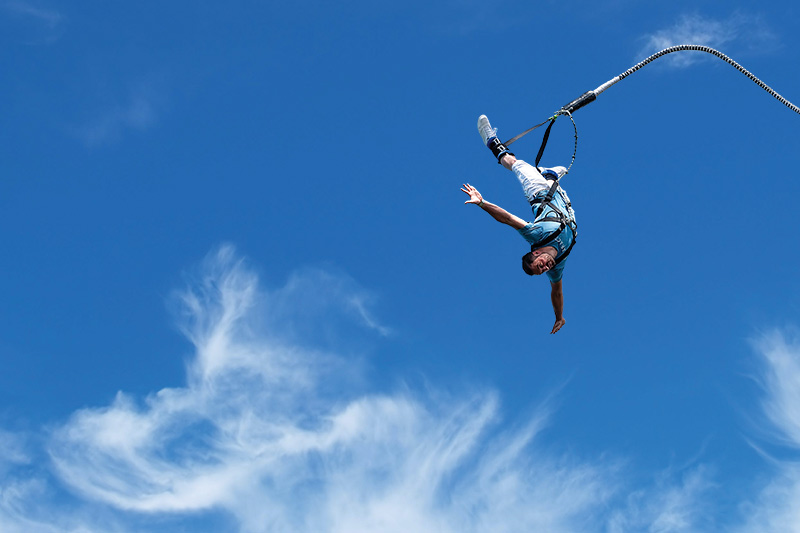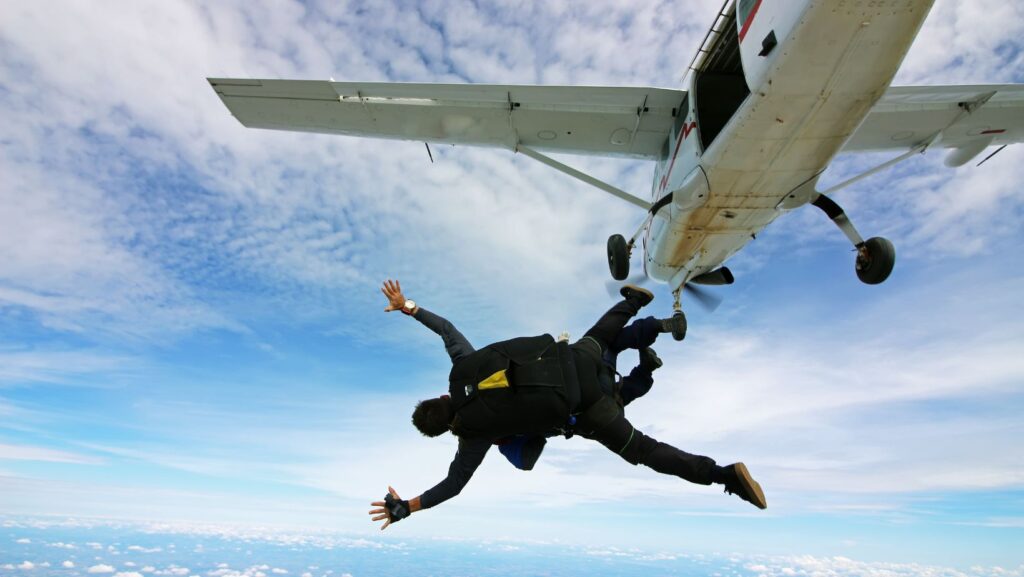If your idea of excitement usually comes from online slots uk, switching to real-world adrenaline sports can feel like stepping from a virtual reel into mountain air. The same instincts you use for bankroll management—planning, risk limits, and steady nerves—translate neatly to bungee jumps, via ferrata traverses, and the long path toward wingsuit flight. Below, you’ll find the best places to try each activity and the prep that keeps the experience intense yet controlled.
Before you pick a spot or book a course, it helps to grasp what each sport demands. Bungee is a single, high-energy leap that rewards headspace and trust in equipment. Via ferrata blends hiking with protected climbing, letting non-climbers sample vertical terrain using fixed steel rungs and cables. Wingsuit is an advanced track for licensed skydivers—more marathon than sprint—where discipline beats bravado every time. The result in all three cases is the same: a surge of focus you’ll feel in your bones.
Where to try it: world-class locations that deliver the rush
Intro. Picking the right venue matters as much as your mindset. For bungee, iconic sites combine height, scenery, and impeccable operations. For via ferrata, look for routes with clear access notes and graded difficulty. For wingsuit, choose drop zones that follow national standards and offer structured progression.
Table — Signature spots, seasons, and ballpark costs.
| Sport | Signature spot | Why it’s special | Typical window | Entry bar & notes | Ballpark price* |
| Bungee | Verzasca (Contra) Dam, Ticino, Switzerland | Famous “GoldenEye” jump off a 220 m dam; cinematic setting. | Apr–Oct (weather dependent) | Adult health screen; professional rigging | €200–€300 |
| Bungee | Bloukrans Bridge, South Africa | ~216 m from Africa’s highest bridge; long freefall. | Year-round (Garden Route) | Operator briefing; photo/video add-ons common | $90–$150 |
| Bungee | Nevis Bungy, Queenstown, NZ | 134 m canyon jump via suspended pod—wind and exposure add spice. | Year-round | Access by operator shuttle only | NZ$245–$345 |
| Via Ferrata | Telluride, Colorado, USA | Moderate “2B” exposure with airy traverses above a box canyon; no cable toll. | Late May–Oct (snow dependent) | Bring proper kit or hire a local leader | Free route; guide/gear $150–$300 |
| Via Ferrata | Mürren, Bernese Oberland, CH | Ladders, wire bridges, and a head-spinning void beneath your feet. | Jun–Oct | Book a certified leader if new | CHF 150–CHF 250 (guided) |
| Via Ferrata (multi-day) | Via delle Bocchette, Brenta Dolomites, IT | Historic hut-to-hut traverse on famed ladders and ledges. | Jul–Sep | Alpine huts reservation; weather savvy | €70–€120/day (huts & kit) |
| Wingsuit (training) | Skydive Perris, California, USA | Structured First Flight Course; clear safety protocols. | Year-round (SoCal weather) | Minimum 200 jumps + B-license track | Course pricing varies |
*Prices are indicative for 2024–2025 and vary by package, media, and currency swings.
Takeaway. Aim for venues with clear technical facts (height, grade, prerequisites) published by the operator or local clubs. Those details are your first risk filter and help you set expectations before you step to the edge.
How to prepare: the right kit, training blocks, and mindset
Intro. Preparation for these sports is a blend of gear, technique, and self-control. Bungee requires little physical training but rewards breathing drills and a calm pre-jump routine. Via ferrata demands sturdy mountain sense and a compact kit that keeps you clipped at all times. Wingsuit is a graduate program for skydivers: the rulebook and jump-number thresholds aren’t flexible—and that’s a good thing.
List — Practical checklist you can use right now.
- Medical & headspace check. No recent injuries, vertigo you can’t manage, or conditions your doctor flags. A short breathing cadence (4-in, 6-out) reduces jitters before a bungee countdown.
- Footwear that bites. For via ferrata, bring sticky-soled approach shoes rather than squishy runners. They edge better on iron rungs and polished limestone.
- Fall-energy kit for ferrata. Use a certified energy-absorbing lanyard set with dual auto-locking carabiners and a proper waist-and-leg safety belt. If you’re new, book a qualified instructor; it’s not just about clipping, it’s about when to rest, pass, or retreat.
- Gloves and helmet. Gloves protect on wire rope; a helmet matters in gullies where small stones get kicked loose.
- Weather windows. Wet steel is slick; electrical storms are a hard no on ridges and ladders. Build a “bail-out” mindset: the mountain will still be there next week.
- Skydiving progression for wingsuit. Logbook proof of at least 200 skydives and a current national license (e.g., USPA) before any wingsuit course. Many drop zones, like Skydive Perris, require those minimums plus a dedicated First Flight Course.
- Currency in the air. Those 200 jumps shouldn’t be ancient history; recent, varied freefall time and canopy drills keep your reactions sharp for suit inflation, separation, and pattern work.
- Insurance and paperwork. Check adventure-sport coverage language for fixed-line climbing, bungee jumps, and skydiving; some policies exclude them unless you add a rider.
Takeaway. Prep turns fear from noise into focus. For ferrata, the right kit and movement habits reduce error rates on ladders and traverses; for wingsuit, formal prerequisites and a real syllabus are non-negotiable steps, not red tape.
What each sport feels like (and how to frame the risk)
Bungee is short, loud, and oddly zen the moment you commit. If you’re trying Verzasca Dam, the leap carries a layer of cinema history thanks to GoldenEye—a fact that somehow steadies the mind when your toes meet the edge. In Queenstown’s Nevis Canyon, the pod ride out over the void sets the stage; those final seconds before the cord loads are the purest test of self-talk you’ll ever do. Bloukrans adds scale—216 meters of air under a graceful arch, with the ocean not far off—that forces respect for the setup and crew routine.
Via ferrata trades that one-and-done surge for hours of steady exposure. Telluride’s 2B grade combines modest moves with canyon-wall emptiness; the mental game is pacing, not power. Mürren spices the day with bridges and ladders strung above Lauterbrunnen’s giant drop; many first-timers hire a certified leader for line management and movement coaching. In the Dolomites, the Bocchette traverses feel like a living museum of alpine engineering—ironwork, ledges, and huts stitching together a rite of passage. Wingsuit sits on a different branch entirely. It’s not a tourist product; it’s a progression layered atop solid skydiving foundations. The 200-jump minimum and license requirement exist for reasons you can feel as soon as the suit inflates: body position controls flight, opening altitude needs discipline, and canopy patterns must account for longer glide. The U.S. standards spell that out clearly, and reputable drop zones echo the same thresholds.
Budgeting and booking smarts
Treat your plan like a betting slip you only fill out after checking form. Lock in refundable options when weather is fickle, especially for via ferrata routes at higher elevations. On bungee day, prepaid media packages are tempting; decide up front so the sales chat doesn’t distract you when you’re getting clipped. For wingsuit courses, ask for a written syllabus, gear rental costs, and coach-to-student ratios, the same way you’d ask a new sportsbook to show its rules page before you deposit.
Managing nerves without killing the buzz
Pre-event routine matters. Eat light, hydrate, and warm up your ankles, calves, and forearms—small joints do a lot of work on ladders and landings. For bungee, rehearse your stance and count with staff while you’re still a few steps back from the edge; when your toes get to the line, act on the plan you agreed. On via ferrata, practice three-points-of-contact on a low rung or boulder before you clip to the first cable; if anything feels off, speak up early. Wingsuit candidates: bring humility. You’re an advanced student now, and the coach’s corrections are the path to fun, efficient lines.
Who should sit this one out (for now)
If you’re recovering from a concussion, joint surgery, or you struggle with fainting at height, postpone bungee and ferrata days until you get medical clearance. If you’re not a licensed, current skydiver with triple-digit jumps, wingsuit isn’t on the menu yet; put that energy toward AFF, canopy courses, and a B-license checklist first.
Final take
Adrenaline sports don’t need to be reckless to be unforgettable. Choose venues with transparent facts, approach prep like a pro, and treat nerves as information, not an enemy. Whether you’re standing on a dam made famous by a movie leap, edging across iron rungs above a valley, or logging the skydives that one day lead to your first wingsuit flight, the real win is the clean, electric focus you get to carry home. And if your gaming habit lives online, you already know the drill: set limits, respect the rules, and chase the kind of stories you’ll still be telling in ten years.


